
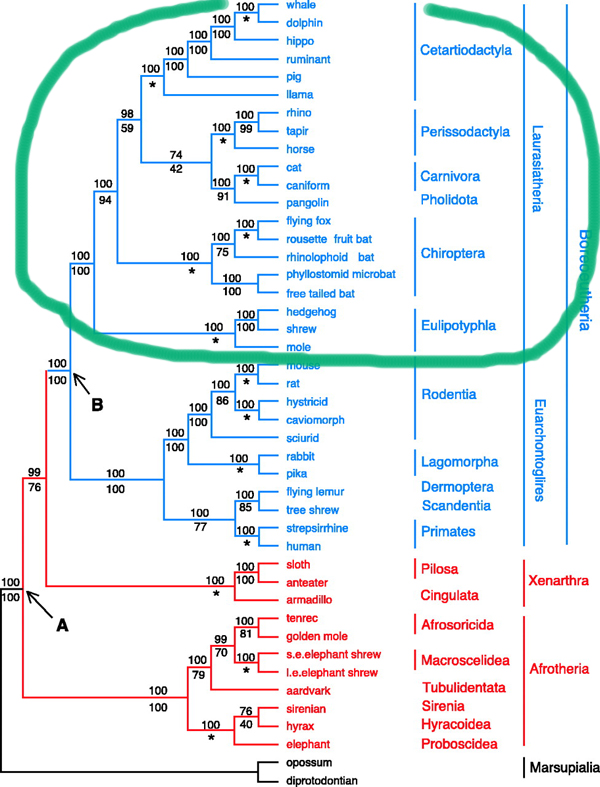
Laurasiatheria is comprised of eight orders:
- Cetacea
- Artiodactyla
- Perissodactyla
- Canivora
- Pholidota
- Chiroptera
- Soricomorpha
- Erinaceomorpha
In some phylogenies (including Murphy et al. 2001) Soricomorpha and Erinaceomorpha are combined into a single group called Eulipotyphla.
The fossil record on whale evolution
| Common name |
baleen whales |
| # of genera |
6 |
| # of species |
10 |
| Distribution |
all the oceans of the world |
- General characteristics
- Largest animals ever known (living or fossil)
- Mostly plankton feeders
- Populations have been driven near extinction by hunting
- Foraging adaptations
- Lack teeth as adults
- Have plates of baleen
baleen in a humpback whale
- Horny epithelial material in longitudinal strands
another view of baleen
Close-up view
- 130-400 plates
- Telescoped maxilla extends infraorbitally
- Methods of feeding
- Skimming (eg, right whales)
video clip of right whale skimming
- Gulp-feeding (eg, rorquals: blue whale, humpback whales, fin whales)
Gulp-feeding in humpback whales is a cooperative behavior:
- Bottom-ploughing (eg, grey whale)
- Migrations
Humpback whale
Gray whale
B. Suborder Odontoceti
| Common name |
toothed whales |
| # of genera |
43 |
| # of species |
67 |
| Distribution |
all oceans and all seas connected to oceans, freshwater rivers and lakes (North and South America, Asia, Africa) |
- General characteristics
- Most diverse suborder of Cetaceans
- Asymmetry of cranial bones
- Telescoped maxilla extends supraorbitally
- Foraging
- Many of them are carnivorous
- Many more teeth than the typical pattern, OR lost all (or all but one) teeth
- Teeth are homodont and cone-shaped
- Respiratory canal and food passages are completely separated by specializations in the glottis and larynx
- Interesting examples
- Sperm whale
- Narwal
cranium
- family Delphinidae
spotted dolphin
- family Platanistidae
Ganges River dolphin
Amazon river dolphin
- General characteristics
- Two enlarged digits share the weight of the body about equally (paraxonic)
- Upper incisors and canines lost or reduced
- Antorbital pit in many species
- Males (and sometimes females) have weaponry
- tusks
- antlers
- horns
- Digestive tract morphology
- Suborder Suinae
- Suidae
- Tayassuidae
- Hippopotamidae
- Suborder Ruminantia
- Camelidae
- Cervidae
- Giraffidae
- Antilocapridae
- Bovidae
- Moschiidae
male with tusks
- Tragulidae
| Common names |
horses, tapirs, rhinos |
| # families |
3 |
| # genera |
6 |
| # species |
17 |
| Distribution |
Africa, Asia, S. America |
- General characteristics
- Unguligrade limbs
- Enlarged central digit carries most of body weight (mesaxonic)
- Elongated skull
- Canine teeth reduced or absent
- Complex ridge pattern on cheek teeth
- Simple stomachs with large caecum (hind gut fermenters)
- Families
- Equidae
- Rhinocerotidae
- Tapiridae
IV. Order Pholidota
| Common name |
pangolin |
| # of Genera |
1 |
| # of Species |
7 |
| Distribution |
Africa, S.E. Asia |

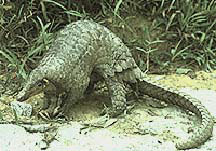
- General characteristics of the order
- Name means "scaly ones"
- Major diagnostic character is the scales that cover their bodies
- Made of keratinized epidermis
- Periodically replaced as they wear and fall out
- Leaf shaped
- Cover top of head, top and sides of body and limbs, and entire tail
- Parts without scales are hairy
- Arboreal ones have prehensile tails, terrestrial ones have short tails
- Long, tubular rostrum
- Long sticky tongues (extends all the way back into the chest cavity when
retracted)
- No teeth
- Horny epithelium with "teeth" in the pyloric region for smashing
insects
- Digging limbs
- Plantigrade
- 5 digits
- Long claws
- Ecology and behavior
- Insectivorous
video
- Some are terrestrial, some arboreal
- Roll into a ball as an antipreditor defense
V. Order Carnivora
| Comon name
| dogs, cats, bears
|
| Families
| 15
|
| Genera
| 126
|
| Species
| 287
|
| Distribution
| Nearly worldwide
|
- Name means "flesh eater"
- Range in size from least weasel (mouse-sized) to Kodiak brown bear (terrestrial; up to 800 kg) and male southern elephant seal (aquatic; 3600 kg)
- General characteristics
- Teeth
- Canine teeth
- Carnassial pair (blade-like fourth pre-molar and first molar) (Fig. 15.4)
- Sharply defined mandibular fossa, where mandible articulates with cranium (some species)
- Long rostrum with complex turbinal bones
- Well developed anal glands
- Modes of life (terrestrial, semi-aquatic or aquatic)
- Terrestrial and semi-aquatic forms
- Plantigrade or digitigrade (depending on extent of cursoriality)
- Four or five toes to each foot
- Long, sharp claws on all digits
- fusion of wrist bones
- Aquatic forms (pinnipeds)
- Limbs enclosed within body up to knees and elbows
- Elongated metatarsals and metacarpals, webbing between digits to produce flippers
- Large body size
- Blubber
- Nostrils are slits that must be forced open
- Nipples and external genitalia are withdrawn into slits
- Most breed and all give birth on land, molt on land
- Respiratory system adaptations
- Phylogenetic history and selected families
- Felidae (cats)
skull
- Hyaenidae (hyenas, aardwolf)
- Herpestidae and Eupleridae (mongooses, meerkats)
skull
- Viverridae (civets)
skull
- Canidae (dogs, wolves, foxes, jackals)
- Mustelidae (weasels, otters)
skull
- Procyonidae (racoons)
- Ursidae (bears)
- Otariidae (eared seals)
- Odobenidae (walrus)
- Phocidae (earless seals)
VI. Order Chiroptera
- Forelimbs modified as wings (the only true flying mammals)
- Radius (forearm), metacarpals (hand) and phalanges (fingers) #2-#5 greatly elongated
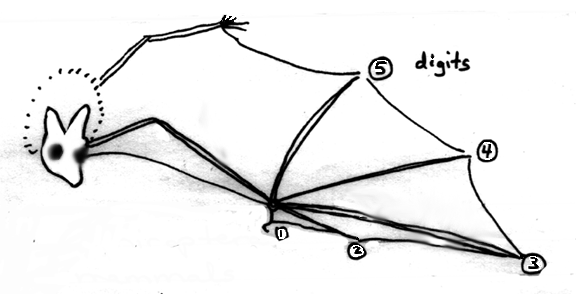
- Enclosed in a web ( patagium , 2 layers of skin, muscle, connective tissue)
- Claws on pollex and all hind digits
- Keel on sternum
- Ecology and behavior
- Widely varied diets
- Insects
- Fruit, nectar, pollen
-
- 1) long snout
2) long tongues
3) specialized facial and body hairs to trap pollen
4) pollen is their primary source of protein
- Fish and small vertebrates
-
- 1) echolocate on water surface
2) catches fish with feet
- Blood
-
- 1) heat sensing pits in nose leaf
2) specialized incisors
3) saliva contains anticoagulant
4) specialized kidneys
- Nocturnal
- Gregarious, roost in caves and hollow trees
- Hang upside down
- Easier to take off? video (at 2:50)
- Leg bones too delicate to support body weight?
- Hip bones reversed to allow control of
uropatagium? video (at 1:00)
- Reproductive variants common
- Ancestry is murky
- Earliest fossil bat Icaronycteris (60 mya) (Fig. 12.10)
- Fully formed wings
- Skull morphology indicates ability to echolocate
- Proposed phylogenies
- Superorder Archonta - Based on features of the visual system ("Pettigrew hypothesis", no longer supported)
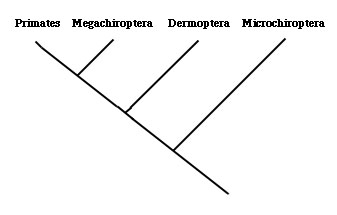
- Superorder Archonta - Based on genetic and morphological data (no longer supported)
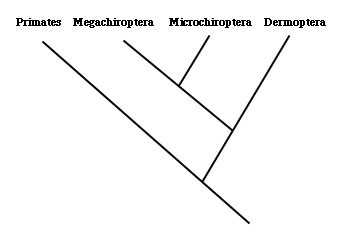
- Based on more recent genetic data, leading to new proposed suborders (Yinpterochiroptera and Yangochiroptera)

VII. Order Erinaceomorpha
| Common name |
hedgehogs |
| # of Genera |
7 |
| # of Species |
21 |
| Distribution |
Africa, Eurasia, Southeast Asia |
- Mouse- to rabbit-sized
- Have spines (short ones) - roll into ball if threatened
- Omnivorous (skull)
- Temperature regulation is heterothermic
- Are capable of hibernation ( obligate in some species)
VIII. Order Soricomorpha
- Talpidae
| Common name |
moles |
| # of Genera |
17 |
| # of Species |
42 |
| Distribution |
Eurasia, North America |
- Mouse- or rat-sized
- Fossorial
- Small eyes, sometimes covered by skin
- Long snout
- Pinnae reduced or absent
- Thick, velvetty fur
- Front limbs rotated out to side (digits out) and very robust
- Long claws
- Keeled sternum
- Behavior and ecology
-
-
1) Insectivorous (see skull)
2) Burrow just under the surface, often leaving ridges
3) Often considered a pest, but they're really helpful to plant growers because they aerate soil and eat insects that damage plants
- Baby star-nosed moles
- Solenodontidae
| Common name
| solenodon
|
| # of Genera
| 1
|
| # of Species
| 2
|
| Distribution
| relict species, only on Cuba and Haiti |
- Muskrat-sized
- Outcompeted by other placentals; no natural predators until domestic dogs and cats
- Defensive behavior is to roll in ball but they lack spines...
- Submaxillary gland toxin, grooved lower incisors
- Soricidae
| Common name |
shrews |
| # of Genera |
23 |
| # of Species |
312 |
| Distribution |
worldwide except Australia, some
of South America and polar regions |
- Among the smallest of all mammals (2.5-180 grams)
- In one subfamily the teeth are pigmented (dark red)
- Very high metabolic rate
- Ecology and behavior
- 1) Terrestrial
2) Prefer mesic habitat
3) Solitary, territorial
- several species of shrews have venomous saliva
- 1) Seems to have effects like a neurotoxin
2) Venom is produced in and secreted from submaxillary salivary glands near the base of lower incisors
3) Delivered via grooves in the lower incisors
4) Probably used to kill prey (mice, frogs)
5) Shrew delivers bite to nape of neck/base of skull, where venom could rapidly get to central nervous system








